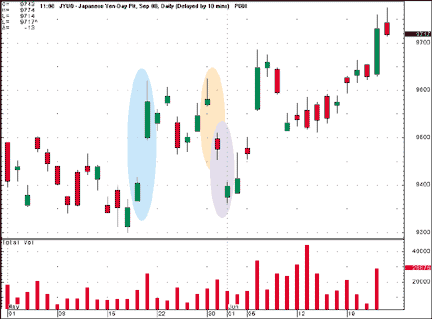BASIC TECHNIQUES
They Happen Frequently, So You Might As Well Get Acquainted With Them
What You Need To Know About Gaps
by Joe Luisi and Jayanthi Gopalakrishnan
Have you ever wondered what gaps are and why they occur? Here are the various types, examples -- and an answer.
Ever had an open position at the close one day, only to find that a significant change in price had occurred when the market opened the following trading day? These changes in price are referred to as gaps and are the result of some action that took place between the close and the next day's open.

FIGURE 1: GAPS. You can have both gapups and gapdowns. Here are examples of both.
With the advent of 24-hour trading and extended-hours trading, it is not unusual to come across significant changes in prices at the open of one day from the previous day's close. All markets trade during specified times. Each market has its own opening and closing times, called market hours or pit session. Some markets are open for eight hours a day, while others are open for a shorter period. For example, the foreign currencies that trade at the IMM in Chicago open at 7:20 am Central Time and close at 2:00 pm, while the live cattle market opens at 9:05 am Central Time and closes at 1:00 pm.
What is happening around the world between the market's close and the next day's open has a dramatic impact on how the markets will open. A market could open at a different price from the previous day's close due to events or reports that come out while a market is closed. A common occurrence is a company announcing its earnings after the bell -- that is, after the stock market closes. If those announced earnings are lower than expected, more sellers will enter the market and the price will be adjusted lower due to the company's perceived weakness in earnings. This may result in prices opening significantly lower than the previous day's close.
GAPS
A gap is an area where no trading has taken place. An opening upgap is when the market opens higher than the previous day's high. An opening downgap occurs when the market opens lower than the previous day's low.
Gaps can be frustrating, especially when you have a winning position going into the close, only to wake up the next morning and find the market has gapped against you. What is more frustrating is the market can easily gap right through your stop price, giving you a bigger loss than you anticipated.
Gaps can open up or down; Figure 1 displays examples of both types. The size of a gap can have some significance for determining price activity. Generally, if a gap is relatively wide, some traders tend to fade the gap -- that is, trade against it. A gap above a certain amount or percentage indicates that the market has overreacted or illiquidity of the afterhours market has taken over. If the gap is up, some traders will sell on the open in anticipation that the market will either close the gap or at least settle down to some extent.
There will be several occasions when you will come across gaps. Although there are various types of gaps, we will limit our discussion to the four major ones.
Joe Luisi is a private trader and can be reached either at 717 558-6407, or at https://www.jaltrading.com. Jayanthi Gopalakrishnan is a Staff Writer for STOCKS & COMMODITIES magazine.
Excerpted from an article originally published in the September 2000 issue of Technical Analysis of STOCKS & COMMODITIES magazine. All rights reserved. © Copyright 2000, Technical Analysis, Inc.
Return to September 2000 Contents